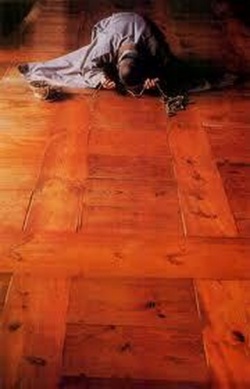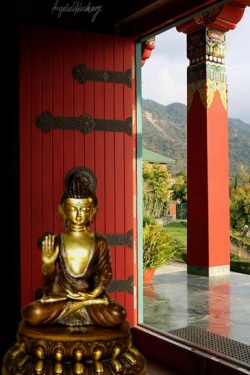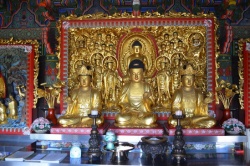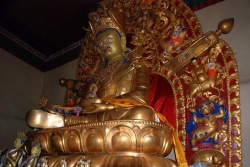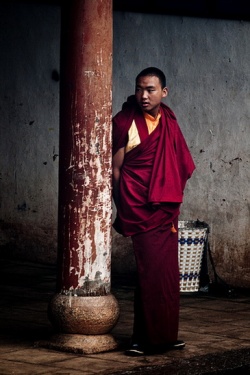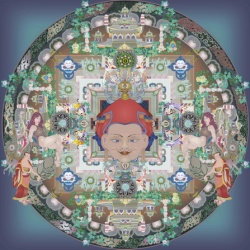Manusya Loka (Human Universe)
Manusya Loka
(Human Universe)
At Citrā earth located at the middle of Trasanālī, there exists manusyaloka having a diameter of 4500000 yojanas. Height of manusyaloka is 100000 yojanas and its circumference is 14230249 yojanas and area 16009030125000 square yojanas. (See TiIoya Pannattī, Mahādhikāra 4).
Dvīpas and Oceans in Manusya Loka
Jambūdvipa having a dia~eter of 100000 yojanas eqists amidst Manusyaloka. Around the circular land mass of Jambūdvipa there exists a ring of Lavana samudra having a breadth of 200000 yojanas. Then there follow the alternate rings of Dhātakīkhanda, Kālodasamudra, Puskaravara dvipa, having their respective breadths of
4, 1, 16 lakh yojanas. Right at the middle of puskaravara dvipa there exists the ring of Manusottara parvata which marks the outer demarcation of manusyaloka having a diameter of 45 (= 1 +2+2 +4+4+8+8+8+8) yojanas. Manusya loka comprises of Jambūdvipa, Dbataklkhanda, and half of Puskaravara dvipa, thus making two and a half dvipas (Adhāī dvipas) (v<kbZ }hi) and two oceans viz. Lavanasamudra and Kālodasamudra.
Jambūdvipa
See the detailed description of Jambūdvipa in the chapter on Jambūdvipa. Detailed description of six regions of Bharataksetra is also found in the chapter on Bharataksetra.
Videha Ksetra
A detailed description of Videha ksetra is found in the chapter on Videha Ksetra. Tîrthankaras, Cakravartīs, NārāyaQas, Pratinārāyanas and Balabhadras happen to be there. Kevalīs and ascetics are always found roaming.
Establishment of Other Ksetras
In Jaghanya bhogabhūmi of Haimavata and Hairanyavata ksetras, there live human beings who are born in pairs and also die together. They have an utkrsta age of one palya, bodily height of one kosa. They use the material obtained from ten types of kalpa trees. In madhyama bhogabhūmi of Hari and Ramyaka ksetras there live human beings having an utkrsta age of two palyas and bodily height of two kośas. In uttama bhogabhūmi of Devakuru (nsodq#) and Uttarakuru (mRrjdq# ) ksetras in Videha, there live human beings having an utkrsta age of three palyas and bodily height of three kośas. All of these bhogabhumis are universal in nature.
In Jambūdvipa, there are 32 karmabllūmis and 6 bhogabhūmis which exist universally and there is not a six-cyclic change of time there. In Bharata and Airāvata ksetras of Āryakhanda, there exist Uttama bhogabhumi, Madhyama bhogoabhūmi and Jaghanya bhogabhūmi during the first, second and third periods of avasarpinī. In 4th period, there exists karmabhūmi alike. that of Videha, and Tirthankaras, Cakravartīs and' great men are born then. In 5th period, due to absence of Tirthankaras and Kevalīs, there is a decay of religion. In 6th period, due to absence of religious kings and ascetics, the human beings live like animals and become devoid of clothes. The six-cyclic change in wheel of time does not take place any-where other than Bharata and Airāvata ksetras.
Mleccha Khandas
There are 5 mleccha khandas in each of the 32 Videhas and Bharata and Airāvata ksetras each. Thus there are 170 (= 5 X 32.+ 5 x 2) mleccha khandas in Jambūdvipa. In mleccha Khandas and 110 towns of Vidyādharas at both the srenis of 32 Videhas there exists a situation alike to that at the begining of fourth period of avasarpini and in mleccha khandas and 50 and 60 towns of Vidyadharas at southern and northern Srenīs of Vijayārdhas of Bharata and Āirivata ksetras alike to what appears from the beginning to the end of fourth period of avasarpanī.
Parvatas=
There are 34 Vrsabha parvatas in all the 34 Āryakhandas. There are 4 Nābhigiris, one in each of the Haimavata, Harī, Ramyaka and Hairarnyavata ksetras. There exist 78 (= 16 at Meru + 4 at Gajadantas + 2 at Jambū and Sālmali trees + 16 at Vaksāra parvatas + 34 at Vijayārdhas + 6 at Kulāchalas) real Jina temples.
Dhātakīkhanda
The dimensions of parvatas, ksetras and rivers etc. in Dhatakī khanda is double those of their respective counterparts in Jambudvipa. The only difference is that there exists one extra Jina temple at two ISvākāra parvatas each in Dhātakīkhanda. The ksetras look ring type. The counterpart of Jambū tree, there exists Dhātaki tree there. More details may be found in the chapter on Dhātakīkhanda.
Pukarārdha Dvīpo
There are two ring type Isvākāra parvatas 8 lakh yojanas long.. each in the south-northern direction. Rest of the description is alike to that of Dhātakikhanda. There exist 4 Merus and a Pu,kara tree.
Besides, it is worth noticing that the diameter of Bharataksetra Jamūdvipa is 526-6/9 yojanas, and outer diameter of Bharataksetra in Dhātakikhanda is 18547-155/212 yojanas and. in Puskarārdha 65446-12/282 yojanas. The increase in dimensions other regions etc. may similarly be understood.
Kubhoga Bhūmis
Tne description of 24 kumānusa (evil human) dvipas at the inner coast of Lavanasamudra may be found in the chapter on 'Lavana samudra'. Similarly there exist 24 kumānusa dvīpas at the outer coast of LavaQasamudra. Thus there ~re 48 kumanu,a dvipas in Lavanasamudra. All the dvīpas are situated at a height of one yojana above the sea water. Similarly there are 48 kumānusa dvīpas in Kālodasamudra. Different types of kumānusas having a peculiar animal limb, just a horn, tail or face etc., are born at different dvīpas. More details may be found in the chapter on 'Lavanasamudra'. Here it is worth mentioning that kumānusa described as having a face alike to that of a cow or pig etc. has rest of the body alike to that of a human being. They are born as kumānusas due to their accumulated bad deeds (dqnku) in their previous lives (see Trilokasāra, vv. 913 to 921). In kumānusa dvīpas there exist kubhogabhūmis ..
Thus considering Bhogabhūmi, Kubhogabūmi, Āryakhanda, Mlecchakhanda and Vidyādhara srenīis as distinct places, there become 5 classes of living places of human beings. Any description in Jambūdvīpa is double in Dhātakikhanda and in Puskarārdha remaining the same as in Dhātakikhanda. For example, if there are 6 Bhogabhūmis is Jambūdvīpa, there are 12 Bhogabhuūmis in Dhatākikhanda and Puskarārdha each.
The statistical data as related to two and a half dvīpas is given as under:
| Śaśvata bhogabhūmi = 6x 5=30 | (Haimuvat, Hari, Deva- kuru, Uttara Kuru, Ramyaka, Hairanyavata) |
| Śaśvata karmabhūmi = 32 X 5= 160 | (Videhas) |
| Asasvata bhogabhūmi = 10 | (5th Bharata and Airāvat each in three periods each of six fold variation of time in a vasarpini and utsarpini each) |
| Asāsvata karmabhūmi = 10 | (As above) |
| Aryakhanda = 170 | (Videhas 160 + Bhatratas 5 + Airāvatas 5) |
| Mlecchakhanda = 850 | (Human beings here are mlecchas by position and not by caste or education) |
| Vidyādhara sreni = 240 | (Human beings here are celestial, expert in education) |
| Kubhogltbhūmi = 96 | [LavaQasamudra 48 + kāloda samudra 48) |
Parvatas
| 1.Sumeru | 5 |
| 2.Jambū, Sālmali trees etc. | 10 |
| 3.Gajadanta | 20 |
| 4.Kulācala (Himavan etc.) | 30 |
| 5.Vaksāra | 80 |
| 6.Vijayārdha | 170 |
| 7. Vrsabhacala | 170 |
| 8. Isvākāra | 4 |
| 9. Nābhigiri | 20 |
Natural Caitālaya
| 1. At Sumeru | 80 |
| 2. At Jambū tree etc. | 10 |
| 3. At Gajadanta | 20 |
| 4. At Kulācala | 30 |
| 5. At Vaksāra | 80 |
| 6. At Vijayārdha | 170 |
| 7. At Iśvākāra | 4 |
| 8. At Mānusottara parvata | 4 |
